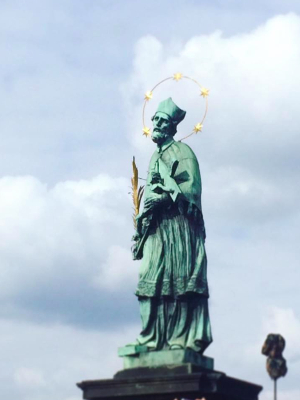…for the first part click here…
Soon, we left the bridge behind. Our tour continued to the St. Nicholas church. Earlier during my stay in Prague, I learnt how to differentiate Gothic, Baroque and Renaissance architecture. St. Nicholas Church is considered the most baroque church in Prague and rightly so. One can sense the ebullient passion with which the church was modified from Gothic into a striking rococo (late baroque) architectural piece. The exterior of the church is as impressive as any other building in the Lesser Town Square, however, every corner of the interior embodies baroque splendor. The top of the church forms a lantern shape with long, slender clear glass windows around it that lets light flow into the church and illuminate the golden ornaments around the structures. That day was particularly overcast and sullen. The church looked somber and shadowy. We could not feel the full extravagance of the structures. However, I was particularly drawn to one statue.
It depicts a king-like figure being revered by an angel and him beheading the devil with his spear. It is hard to notice in the picture but the figure’s facial expression is one of disgust, almost a smirk. His stature indicates an air of superiority and indifference. Late Baroque’s abstract depiction of feelings makes it difficult for us to discern what the figure was actually feeling – maybe disgust of the surrounding normality, maybe pleasure of torture or maybe a feeling totally unfamiliar to humans today. “The Late Baroque: An Introduction” helps us understand the statue better: late baroque period emphasized on man’s control of science, nature thus, control of even imperfections. Baroque operas reflected this obsession of control – subjects in operas during that time glorified and dramatized the power of the people who sponsored the shows. This statue at the St Nicholas Church reminds me of one specific baroque opera story. Roman Emperor Titus escapes a plot of murder and surprisingly, forgives the conspirers. I did not know what to get out of this story – it is undoubtedly an act of uncommon generosity, magnanimity and superiority but it is equally an intentional act to extend the reach of his power. The same reading refers to the Emperor as the “absolute ruler”; he was capable of “godlike goodness” and its total reverse at the same time.

Top of the St. Nicholas Church
Somehow, the church makes me think that baroque was a period of widely revered strong opinions. The text says that it was the Age of Absolutism and, the Age of Science. It was the age of exaggeration with precision. This “dualism of pomp, and extravagance on one hand, system and calculation on the other” seems doubtful at first. But as we can observe through masterpieces like the church itself, exaggeration only looks out of place when it’s not controlled. Even extravagance can be normalized with a bit of structure and accuracy.
The Baroque period was also a period of deep irony. “The Spirit of Prague” associates the period with “violence, enforced exile, a loss of homeland, loss of original religion”. Yet, new preachers came. New, superior-looking churches were built. Alas, none of those could renew lost faith.
…to be continued
published: 19. 12. 2016







